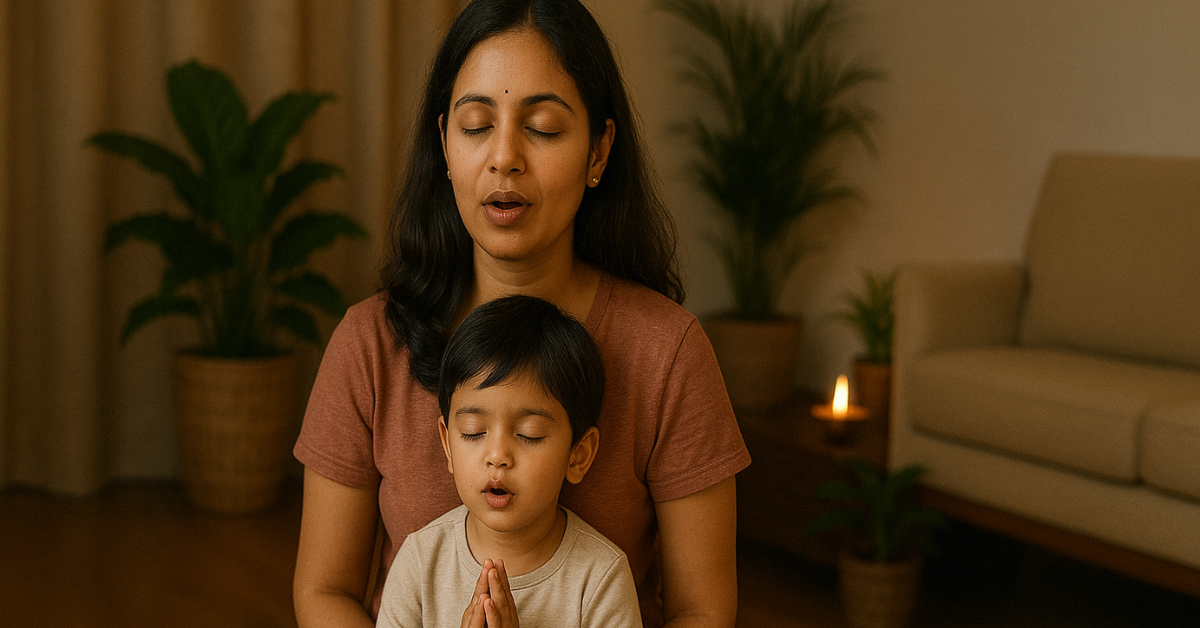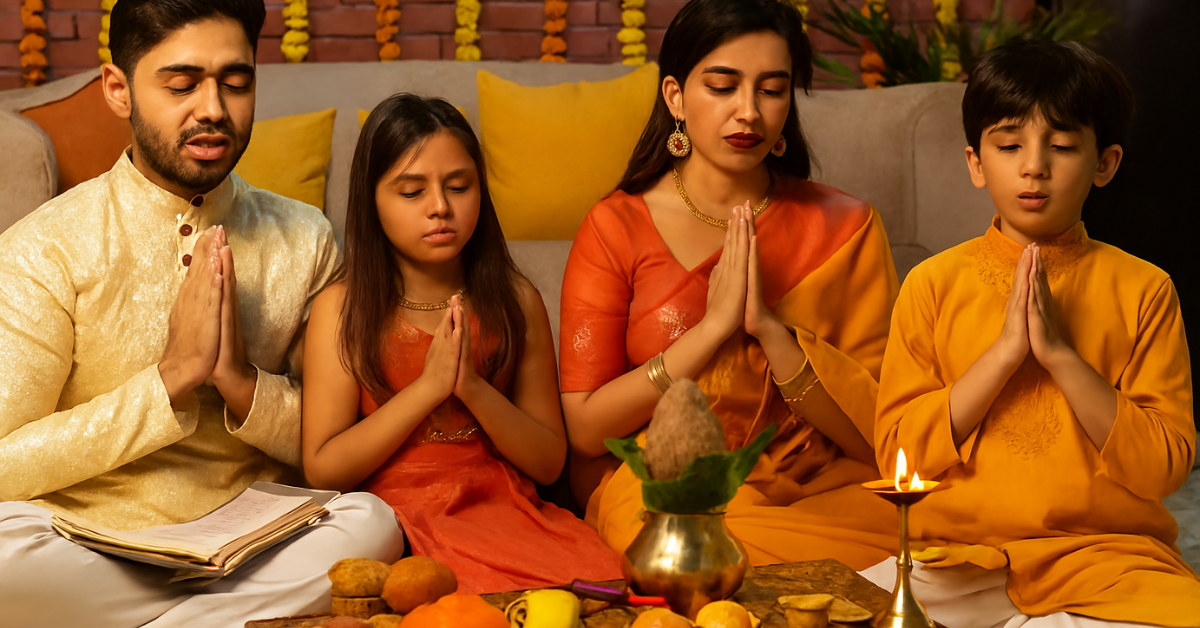Parenting today is noisy—phones pinging, TV blasting, homework deadlines, and endless chores. Many mothers feel exhausted yet worried they aren’t spending enough quality time with their children.
Children too are growing up in a world of screens, fast entertainment, and little real silence. They get bored quickly, feel restless, and often struggle to sleep calmly.
So how can we bring back that sense of peace, presence, and gentle bonding at home?
One simple, timeless way is chanting together. Chanting is an ancient practice, but it’s also one of the easiest, low-cost, heart-centered ways to calm your child’s mind, soothe your own stress, and build an invisible string of trust between you both.
What Does Chanting Mean in Simple Words?
To chant means to repeat a sound, word, or short prayer with love and focus. It can be:
- A universal vibration like “Om”
- A simple mantra like “Om Namah Shivaya”
- A sweet chant like “Hare Krishna Hare Rama”
- Or even a small bhajan line or lullaby
You don’t need deep knowledge of scriptures or Sanskrit fluency. You don’t even need a perfect voice. Chanting works because it calms the breath, quiets the mind, and creates an atmosphere of peace that your child can feel.
Why Do Children Respond So Well to Chanting?
Children naturally respond to rhythm and repetition. That’s why they love rhymes and songs! When you chant softly with them:
- They learn to breathe slowly and deeply
- Their mind focuses on the sound
- Restless energy calms down
- They feel safe hearing your voice
In fact, chanting is like a lullaby that trains your child’s mind to settle into silence. This is priceless in today’s busy world.
Why Parents Should Chant Too
It’s not just about the child—chanting helps mothers and fathers too.
Many mothers say they feel more:
- Patient during tantrums
- Emotionally strong during tough days
- Bonded with their children through shared silence
When you chant, your mind calms down. You become less reactive and more present. This peaceful energy naturally passes to your child.
Benefits of Chanting as a Family
✔️ Helps manage daily stress
✔️ Improves sleep quality for children and parents
✔️ Makes children feel secure and loved
✔️ Connects families with simple spiritual roots
✔️ Creates a soothing bedtime ritual
✔️ Builds discipline gently
How to Start Chanting with Your Child
1️⃣ Pick a Simple, Soothing Chant
Choose short words your child can repeat easily:
- “Om” — The universal sound of peace.
- “Om Namah Shivaya” — Teaches respect for all creation.
- “Hare Krishna Hare Rama” — Joyful and rhythmic.
- Gayatri Mantra — A beautiful light mantra for older kids.
Don’t overthink pronunciation—focus on love and intention.
2️⃣ Find the Right Time
A peaceful moment is key. Good times are:
- Early morning before school
- Evening prayer time
- Before bedtime
- After a warm bath
Some families light a diya or incense stick to create a calm mood.
3️⃣ Keep It Short at First
For toddlers, chanting for 30 seconds is enough!
Older kids may sit for 3–5 minutes.
Gradually, they build patience.
Children learn through repetition—so daily practice matters more than long sessions.
4️⃣ Make It Playful
Children love fun:
- Chant with gentle claps or swaying side to side.
- Ring a small bell at the start or end.
- Use hand actions for each word.
- Share a tiny story about the chant’s meaning.
This makes chanting feel like a calm family game, not a forced rule.
5️⃣ Be Patient and Open
Some days your child will chant happily. Some days they may wriggle, giggle, or refuse. That’s normal!
Don’t scold. Keep chanting softly yourself. Over time, your child will sit longer—because they feel the calm in you.
Adding Meaning: Tiny Tales for Little Minds
Stories make chanting magical. Here are simple ways to share meaning:
Om:
Tell your child that Om is the sound the universe makes when it breathes. It’s the first sound, the sound of everything.
Om Namah Shivaya:
Explain that it means respecting all life—plants, animals, people—like Lord Shiva does.
Gayatri Mantra:
Say it’s like asking the sun for light, wisdom, and kindness.
Children remember feelings more than words. So keep it simple and warm.
Ideas for Different Ages
🍼 Babies: Hum softly during feeding or rocking them to sleep. They’ll feel your calm heartbeat.
👶 Toddlers: Let them repeat one word after you. Add claps or actions.
👦 Older Children: Teach them a short line slowly. Let them lead chanting once they feel confident.
👧 Teens: If they’re open, let them play soft background music or lead the chant for the family.
A Mother’s Story: From Tantrum to Calm
One mother shared: “My 3-year-old was having bedtime meltdowns. I started saying ‘Om’ with him every night, holding him close and rocking him. Within a week, bedtime felt calmer. Now he asks for it himself.”
Another mother says: “My daughter hums ‘Om Namah Shivaya’ when she feels scared. It’s her magic word for feeling brave.”
These small rituals give children tools for life.
Building a Family Ritual
You can weave chanting naturally into your family’s day:
- After morning bath, sit together for 2 minutes.
- Light a diya before dinner, say one chant together.
- Chant softly while putting your child to sleep.
- Play a gentle recording during evening playtime.
There is no perfect way. What matters is that you do it together.
Your Calm is Their Calm
Children don’t learn chanting by lectures. They absorb your energy.
When you sit calmly, breathe slowly, and smile—they feel safe.
In that moment, they learn that peace is not something outside—it’s inside you.
Practical Tips for Busy Parents
- No time? Even 30 seconds counts.
- Feeling shy? Chant softly in a whisper.
- Worried about mistakes? It’s the love that matters, not perfect pronunciation.
- Not religious? Think of chanting as a gentle mindfulness habit.
- Partner doesn’t join? That’s okay—your child needs only you.
The Smallest Sound, The Deepest Bond
It’s not about big spiritual shows. One softly chanted Om at bedtime can help your child sleep feeling safe and loved. Over years, these small moments add up to deep trust.
Your child may forget toys and gadgets. But they’ll always remember your warm lap, your calm voice, and the safe silence you created together.
FAQs
1. How old should my child be to start chanting?
You can start chanting with your child at any age—even with a newborn! Babies find your voice calming and familiar. For toddlers, start with one word like Om or a short line. Older children can slowly learn longer mantras as they get used to it.
2. My child moves too much—how do I make them sit still?
It’s normal for young children to fidget or giggle. Don’t force silence. Start with very short sessions—just one minute. Add claps or hand actions to make it playful. Over time, your child will naturally sit longer because they feel safe and happy chanting with you.
3. Which mantra is best for children who get scared or anxious?
Simple, calming mantras like Om Namah Shivaya or Hare Krishna Hare Rama work beautifully for children who feel scared. You can also softly hum Om while holding them. The sound and your gentle presence help children feel protected, especially at bedtime or when upset.
4. What if my partner or family thinks chanting is unnecessary?
Some family members may not understand at first—especially if they’re not spiritual. Keep it simple. Make it part of your personal time with your child. Over time, when they see how calm and happy your child feels, they may join too. Your child only needs your calm support.
5. Is it okay if I don’t pronounce the words perfectly?
Absolutely! Pronunciation is not as important as your intention. Children feel your love and calm energy more than your words. Start with short, simple mantras you feel comfortable saying. If you wish, you can learn correct pronunciation slowly. The feeling matters more than perfection.



2 thoughts on “How Chanting with Your Child Creates Bond and Calm”